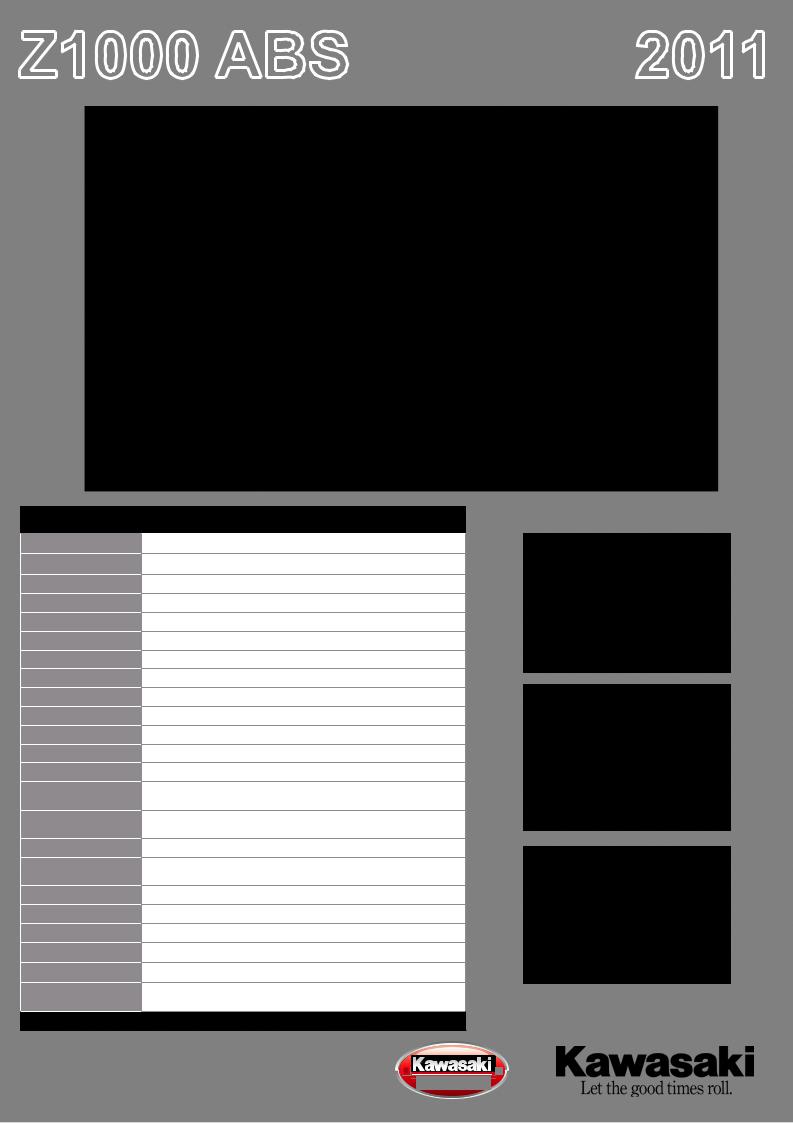Kawasaki Z1000 ABS Manual

Z1000 ABS |
2011 |
|
|
Specifications:
ZR1000EBF
Engine Type
Displacement
Bore & Stroke
Compression Ratio
Maximum Torque
Fuel System
Ignition
Transmission
Rake/Trail
Front Wheel Travel
Rear Wheel Travel
Front Tire Size
Rear Tire Size
Front Suspension
Rear Suspension
Wheelbase
Front Brake
Rear Brake
Fuel Tank Capacity
Ground Clearance
Seat Height
Curb Mass
Colours x 2
Inline 4-Cylinder, 4-Stroke, Liquid-Cooled, DOHC 16-Valves
1,043 cm³
77.0 x 56.0 mm
11.8:1
110 N-m @ 7,800 rpm
DFI 4 x 38 mm with oval sub throttles
TCBI with digital advance
6-Speed with Positive Neutral Finder
24.5°/ 103 mm
120 mm
135 mm
120/70ZR-17
190/50ZR-17
41 mm inverted fork with adjustable rebound damping and spring preload
Back-link Horizontal Monoshock with stepless rebound damping and spring preload adjustability
1,440 mm
Dual 300 mm semi-floating petal discs, dual radial-mounted, Opposed 4-Pistons and ABS
250 mm single petal disc with single-piston calliper and ABS
15.0 litres
140 mm
815 mm
221 kg (includes full fuel tank and all fluids at correct levels)
Candy Lime Green (17P) with Ebony (H8) or Ebony (H8)
Key Features:
1,043 cm³, Inline 4-Cylinder, Liquid-Cooled
New Upswepted Muffler Design
Inverted 41 mm Forks, 300 mm Petal Discs, Radial Mount Callipers with ABS
(Specifications subject to change without notice.)

2011 Z1000 ABS
Other Super Naked models are often no more than supersport models with the fairings removed, so the scope of the design is limited. As the 2010 Z1000 ABS was designed from scratch, there were no design limitations and the new Z1000 has a stunning visual impact.
Supersport-based engines and chassis offer high performance, but the number of riders who are able to enjoy this performance on the street is limited. Rather than pursuing speed and performance figures, Z1000 development focused on the excitement derived from riding a sport bike on the street, thereby achieving a high riding impact.
Engine tuning focussed on the feeling the rider gets when opening the throttle. Open the throttle at any engine speed and the engine pulls strongly, so sit back enjoy the experience of the new Z1000.
GRUNTY HIGH-TORQUE ENGINE
* The engine offers greater power and torque than that of its predecessor. The new displacement was chosen to keep the Z1000 name.
*The crankshaft was lowered to allow for the longer stroke and the engine’s dimensions are about the same despite the 90 cm³ displacement increase.
*A bore slightly smaller than the 2009 Z1000 but larger than the ZX-10R, and a stroke longer than both, result in an engine very strong in the rev range most used by Super Naked machines.
*A secondary balancer driven off the crankshaft eliminates excess vibration.
*Power delivery is quite linear, but the engine spins up noticeably faster from 7,000 rpm onwards. Silky smooth response from mid-high rpm ensures excellent driveability.
*Crankshaft and transmission shafts are arranged in a straight line to offer the best look for a Super Naked model.
*Good over-rev characteristics mean that power does not suddenly drop off.
FUEL SYSTEM
*Electronic fuel injection feeds the engine exactly the right amount of fuel giving excellent power, fuel economy, driveability and starting.
*Ultra-fine injectors and small bore throttle bodies with oval subthrottles offer ultra-smooth response across the rev range.
* Downdraft throttle bodies allow intake air to travel the shortest possible distance, offering improved performance. Longer funnels are used to offer the best power characteristics for a Super Naked model.
*The fuel tank design features supersport-style flared edges with a slim shape at the rear making it easy to grip with the knees during sports riding.
*Concentrating the tank’s volume toward the rear helped make room for the repositioned ignition key cylinder.
COOL AIR SYSTEM
*Cool air is routed to the airbox from ducts above the shrouds and through the frame to minimise power loss due to heated air. This not a ram-air system.
*A resonator inside the airbox reduces noise at low rpm, and enhances intake sound at high rpm.
*The positioning of the ducts allows the rider to more easily hear the intake sound.
